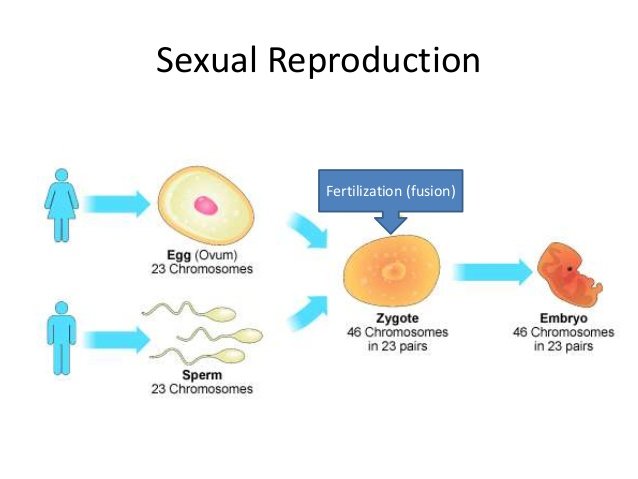Back to: BIOLOGY SS2
Welcome to Class !!
We are eager to have you join us !!
In today’s Biology class, We will be learning about Sexual Reproduction. We hope you enjoy the class!

Sexual reproduction is the process in which new organisms are created, through the combination of the genetic information from two individuals of different sexes. The genetic information is carried on chromosomes within the nucleus of specialized sex cells called gametes.
STRUCTURE OF MAMMALIAN GAMETES
GAMETE
A gamete is a mature sexual reproductive cell having a single set of unpaired chromosome. It can be male or female gamete. They are formed in the gonads (testis on ovaries) through a process called gametogenesis.
MALE GAMETE (A SPERM)
This is called sperm (or spermatozoa) and produced in the male gonads (testis) by a process called spermatogenesis. It is microscopic and unicellular in nature. Usually smaller and more elongated than the egg; about 0.05 mm (0.005 cm) long.

Spermatozoon consists of the following parts:
- Acrosome: It can be found at the upper part of the head, containing lytic enzymes used to dissolve egg membrane to enhance penetration during fertilization.
- Middle piece: It contains mitochondria for the generation of energy used by the sperm for swimming towards the egg.
- Flagellum: The long whip-like tail for propelling the sperm cell
- Nucleus: It can be found in the head of the sperm cell containing genetic materials (DNA-deoxyribonucleic acid) which fuses with the nucleus of the ovum at fertilization.
FEMALE GAMETE

THE OVUM
This is called egg (ovum) and is produced in the female gonad (ovary) by a process called oogenesis. This is larger than sperm, about 0.1mm in diameter.
Each ovum is made up of the following
- Cytoplasm
- A central Nucleus: It contains the chromosomes which carry the genes.
- Granules and yolk droplets: A source of nourishment for the embryo at the early stage of development.
- Plasma membrane: It surrounds the cytoplasm.
- Outer vitelline membrane and jelly coat of glycoprotein.
Note: The nuclei of the sperm and ovum contains chromosome which carries the gene that is responsible for the transmission of characters from parents to offspring.
GENERAL EVALUATION
- What is reproduction?
- Draw a well-labelled diagram of the male reproductive organ in mammals.
- List five structural parts of the female reproductive organ in mammals and state their functions.
- State five distinct differences between the male and female reproductive organs in mammals
- Differentiate between the male and the female gametes in mammals.
READING ASSIGNMENT
College Biology, chapter 16, pages 292-324
WEEKEND ASSIGNMENT
SECTION A
- The following are female sex hormone except A. oestrogen B. progesterone C. testosterone D. oxytocin
- The site of production of sperm is A. epididymis B. seminiferous tubules C. seminal vesicle D. penis
- Fertilization takes piece in the A. uterus B. vagina C. oviduct D. vulva
- ____ parts of the male gamete dissolve the egg membrane to enhance penetration A. nucleus B. acrosome C. flagellum D. vitelline membrane
- The process by which the male and the female gamete are formed in the gonads is referred to as ____ and _____
SECTION B
- Draw a well-labelled diagram of the sperm cell and state the functions of the labelled parts.
- Differentiate between sexual and asexual reproduction
We have come to the end of this class. We do hope you enjoyed the class?
Should you have any further question, feel free to ask in the comment section below and trust us to respond as soon as possible.
In our next class, we will be learning about Reproduction in Plants. We are very much eager to meet you there.

I like this class of reading it really help me alot
Interesting topic